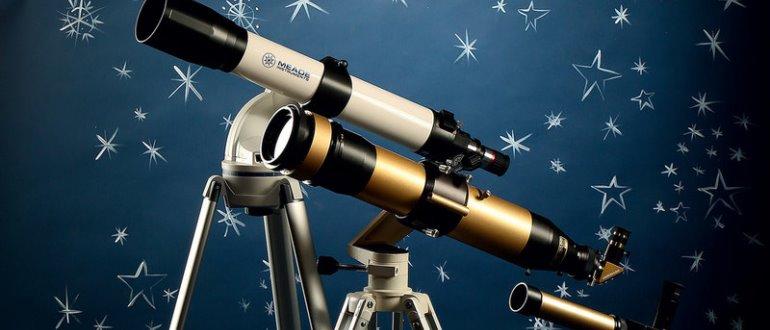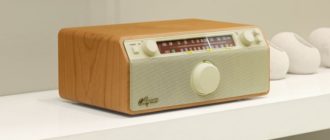Observing the starry sky is a rather fascinating activity, and for a long time not only professional astronomers, but also amateurs have been interested in it - there are many discoveries that were made by them. You can look into the depths of space at the observatory, where very powerful optical instruments are installed, but there are also telescopes for home use.
We decided to devote today's review to amateur telescopes. On the market, they occupy a not too large niche, but there are plenty to choose from. On sale there are products designed for beginners, adolescents, as well as people who have long been engaged in space exploration. Before proceeding to the consideration of specific models, we decided to first give some recommendations regarding the choice of telescopes.
Summary of the rating:
What is the basis for choosing a good telescope?
First of all, it is worth considering that the telescope is a rather complex structure, with its help you can see objects located at a considerable distance from the observer. In shape, it is a pipe, on one side of it is a lens that collects light, or a concave mirror - the lens. On the other is the eyepiece through which a person will look at the image.
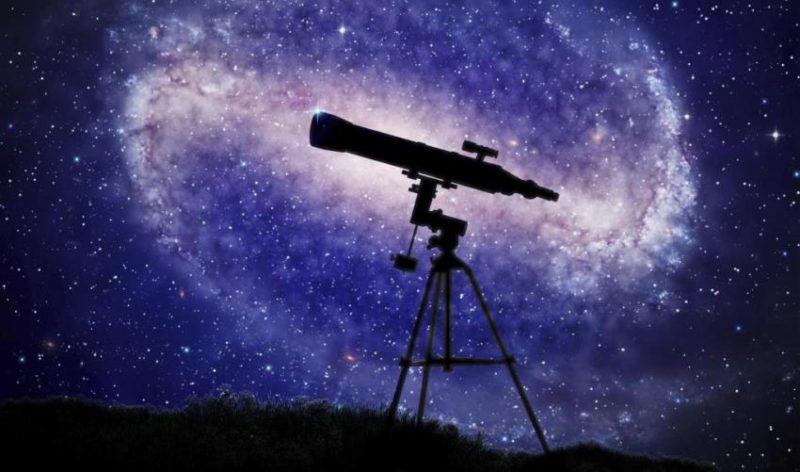
Even the simplest telescopes for the most part are equipped with a special finder that allows you to see specific space objects. In addition to them, a light filter can be provided, which somewhat dims the radiance of stars, allowing them to be viewed without harm to the eyes.
More complex models are equipped with various electronic equipment, a GPS navigator, even an electric motor. Most often on sale you can find the so-called refractors or lens telescopes. Their design is the simplest - the lens and eyepiece are located on the same axis, and the picture is transmitted directly in a straight line. They are not too expensive and are perfect for beginners. With their help, you can easily view most of the objects in the solar system. It is recommended to use a similar telescope away from the city, where there is no illumination of the sky with street light.
The reflector or mirror telescope has a slightly different principle of operation - the beam is transmitted due to two concave mirrors, one of which is located in the lens, and the other reflects the picture at an angle, since the eyepiece is located on the side. Such telescopes are most suitable for exploring deeper space - galaxies, stars, nebulae. There are many settings here, so it will not be so easy for a teenager or a beginner to cope with adjusting the picture.
Catadioptrics combine the advantages of mirror and lens models. These telescopes are considered universal - with their help one can consider both relatively close and very distant objects. The image obtained in the eyepiece of such a telescope is very clear, so you can photograph your favorite objects.
In developing our ranking of the best telescopes in 2019, we took into account user reviews and professional astronomers, as well as the price-quality ratio of the device.Our review did not include the most expensive products, which are likely to be beyond the means of every lover to observe the starry sky. Now let's look at the main characteristics of the products included in the rating.
Universal Beginner Designs
3. Veber 400/80 AZ
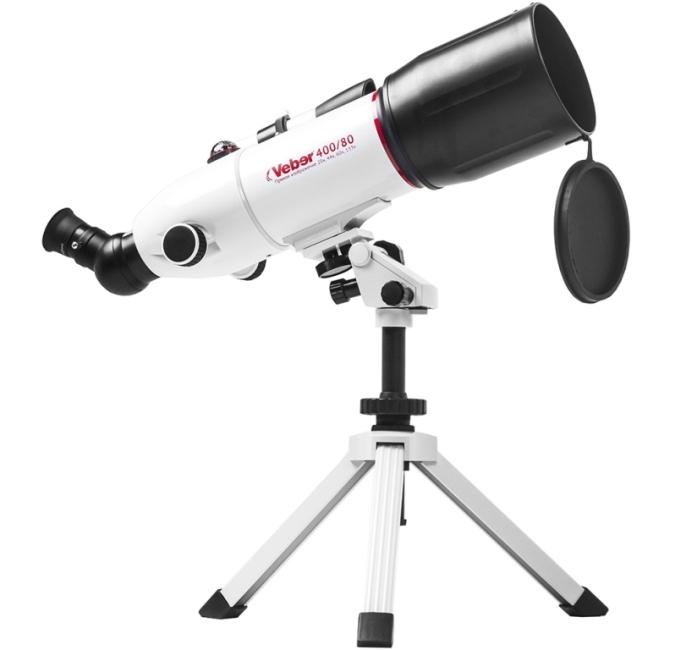
Our rating opens with a design characterized by compactness, excellent aperture ratio and reasonable cost. The telescope is perfect for long trips to nature, but it can be installed at home or in the apartment. The eyepiece is equipped with a Schmidt prism, the picture is straight, not mirrored. The maximum magnification is 160 times - through such a telescope you can see lunar craters with a diameter of about 7-8 km, see the rings of Saturn, the clouds of Jupiter and so on. The lens here is achromatic, due to which the picture is as clear and sharp as possible over the entire field of view - there are no distortions and color at the edges.
Particular attention should be paid to the ocular part. It is at an angle of 45 degrees to the axis of the device, and if necessary, can rotate, locking in one of eight positions. Thanks to this possibility, observation becomes the most comfortable - you can watch the starry sky both in a standing and in a sitting position. The picture is direct, not mirror. The design provides for an azimuth mount, which even a child can handle, there are two micrometric handles responsible for pointing, and a viewfinder is also installed. Due to all these elements, the telescope can be accurately brought to the target. A tripod is not provided in the kit, it will have to be purchased separately.
Benefits:
- The parameters are balanced just perfect;
- One of the lightest in our review - its mass is only 4 kg;
- Reasonable cost.
Disadvantages:
- The mount should be handled most carefully - there is a high probability of incapacitating it.
2. Levenhuk Strike 80 NG
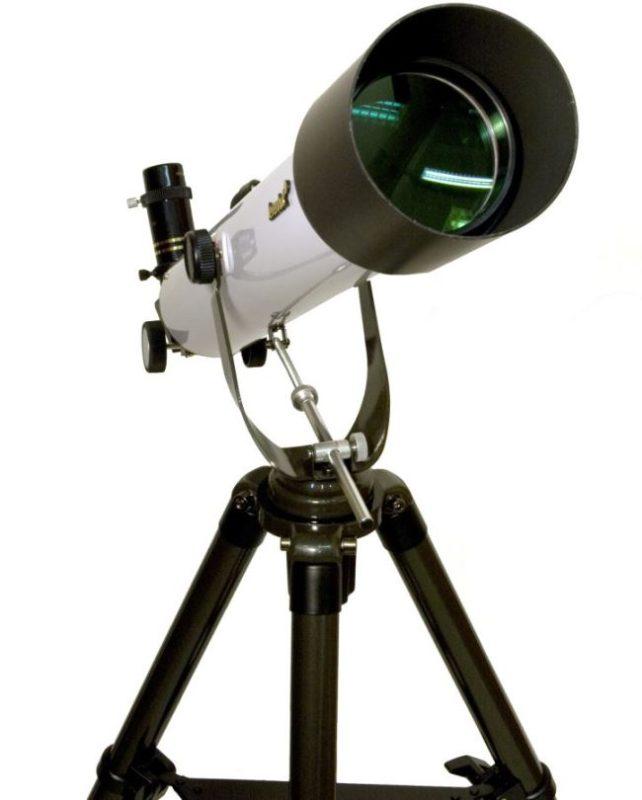
A telescope-refractor, it has a small mass, and if necessary it can be carried in one hand. In the disassembled state, the dimensions are small - about 80 cm, so you can ride with such a telescope even in public transport. The design provides for a reversing prism, due to which the picture is obtained not inverted, but in a straight line. The telescope is considered universal, since it can also be used to observe earthly objects, it is used even in the daytime. The pipe of the device is painted white, practically does not heat up in direct sunlight. The build quality of the device is excellent. The design is very neat and reliable.
The viewfinder has a red dot called Starpointer, which makes it even more convenient in terms of use, it is quite simple to find the necessary object in the sky. Before proceeding with observations, it is worth setting the viewfinder coaxially to the main pipe of the product. The focuser is made of high-quality plastic of increased stiffness, characterized by a soft stroke, there is no backlash. The telescope has an alt-azimuthal mount Yoke, thanks to which the weight of the product is lightened, and it becomes even easier to manage. There is a special lens hood, which is designed for high-quality protection of the lens even from strong shocks and from dew. It is installed on a tripod very quickly. A special planetarium program is supplied with the telescope, there is also a book for beginner astronomers and a compass. All these points allow you to quickly master the basic skills of using the telescope for its intended purpose.
Benefits:
- The largest useful increase is 360 times;
- The viewfinder is equipped with a red dot;
- The kit has everything you need for comfortable work with this equipment.
Disadvantages:
- Weak aperture, so using the telescope is recommended only for observing dim celestial bodies.
1. Celestron AstroMaster 130 EQ
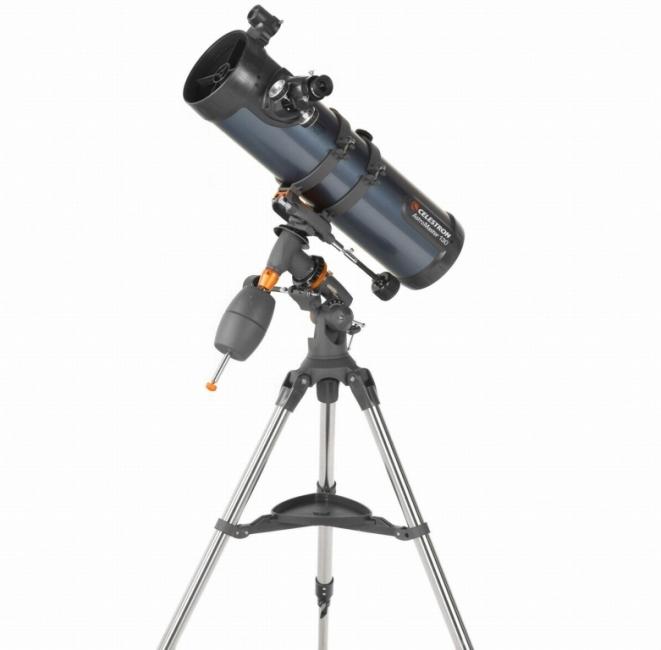
This is a very functional product, which is characterized by excellent quality of both the assembly and the resulting image. The optics are powerful, all the mechanical elements are reliable, it is very simple to use this telescope. Through it, you can consider the mass of space objects, and the picture will be bright and contrast. The design is modern and interesting. Such a telescope will be most suitable for a person who is seriously interested in astronomy. Using this equipment, you can see many stars in our galaxy, various constellations - Sagittarius, Eagle, Scorpio, Cassiopeia and many others. It is natural that with a telescope you will be able to see all the major planets of our solar system, various nebulae and so on.
The viewfinder with a red dot is supplied, in addition, there are two eyepieces, the diameters of which are 10 and 20 mm. The first allows you to get a picture enlarged 33 times, the second - 65 times. With such eyepieces, you can quickly catch the desired object. Double and five-fold Barlow lenses provide high power to the telescope; special filters for the moon and stars are also provided. At maximum settings, you can get an increase of 307 times - in this case, you can consider craters, paths, the famous Martian channels and so on.
Benefits:
- Reasonable cost;
- High image quality;
- Strong and reliable assembly;
- Low weight.
Disadvantages:
- At first, catching a celestial body in the lens will be quite problematic.
The best telescopes for deep space
3. Synta Sky-Watcher BK 1149EQ1
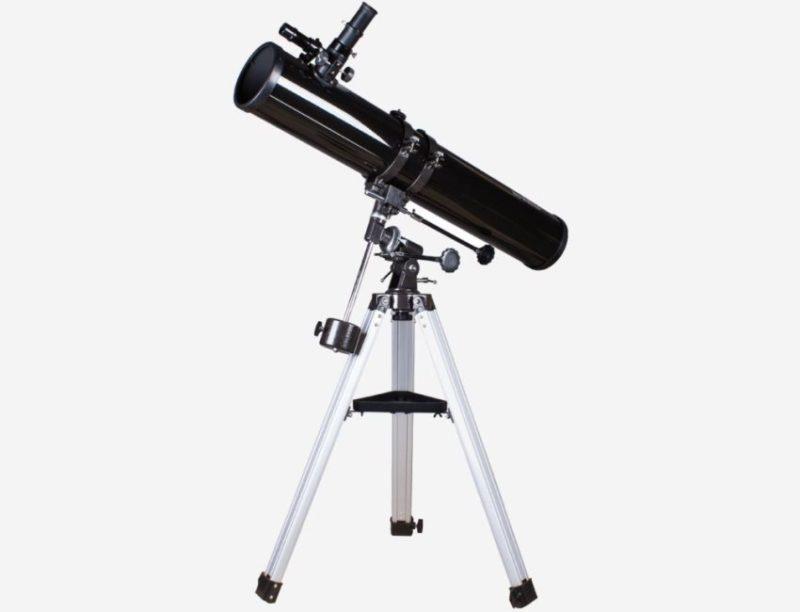
This is a fairly high-quality Newton reflector, equipped with an equatorial mount EQ1. Thanks to this device, you can see many galaxies, various star clusters, nebulae and other space objects that are far from the Earth at a distance of a huge number of light years. The manufacturer claims that this telescope is even suitable for observing closer objects belonging to the solar system - planets, asteroids, comets, satellites and so on. The image is quite bright, various kinds of chromatic aberrations are not observed. The design provides a very convenient optical finder. Two eyepieces are supplied with the telescope - their diameters are 25 and 10 mm. The first is intended to obtain an overview picture, the second is used to study the selected space object in more detail.
The optical tube is placed on a special equatorial mount, with which it is possible to compensate for the daily movement of objects across the horizon. All mechanisms are characterized by smooth movements, no jerks are provided. If necessary, an electric motor running on a lithium-ion battery is located on the right ascension axis. It does not go in the kit, it must be purchased separately.
Benefits:
- Very high performance in terms of aperture;
- If necessary, you can install all kinds of accessories;
- Spherical aberrations of the image are completely absent.
Disadvantages:
- Quite a serious mass - it is 11.7 kg, it is not too convenient to take it on foot;
- The power of the eyepieces leaves much to be desired, astronomers recommend purchasing additional ones to get a better picture.
2. Levenhuk Skyline 76 × 700 AZ
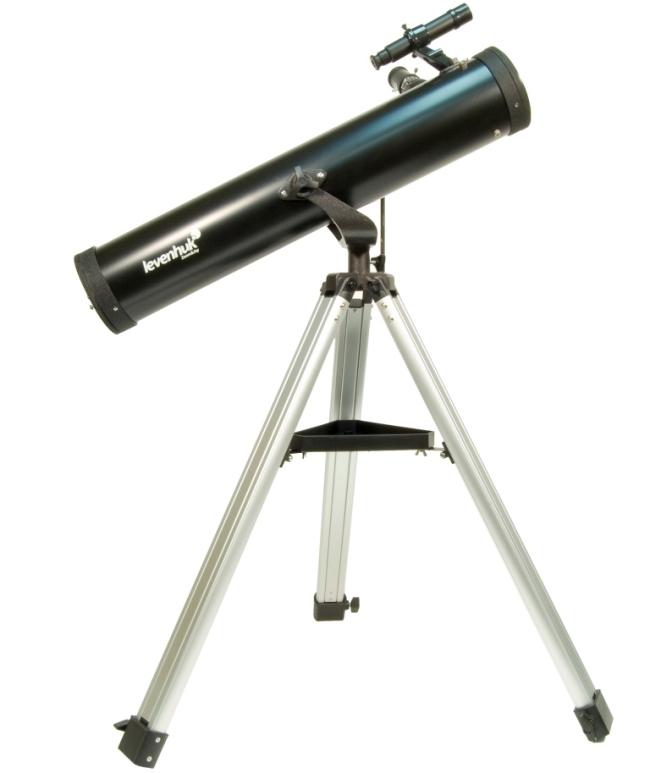
This model, like the previous one, is made on the basis of the classical optical scheme - Newton's reflector. Such a design is ideal as the first tool for a beginner astronomer who only takes his first steps in this field - the telescope does not weigh too much (it can be conveniently transported as ordinary carry-on baggage), it has an acceptable cost and ease of use. The optical scheme does not distort colors, such chromatic aberration is often manifested in inexpensive lens models, it is best seen at the border of fairly bright objects.Complete with a telescope, everything necessary for comfortable observation is supplied.
The telescope mirror has a diameter of 76 mm, thanks to it it is possible to collect light about 100 times more than with the naked eye. Thanks to this quality, it is possible to consider not only the planets themselves, but also their large satellites. It well shows objects located far from the solar system - galaxies, nebulae, all kinds of binary stars or clusters of stars. All mirrors are covered with protective compounds, due to which it is possible to ensure a long period of operation of this equipment. The telescope tube is made of lightweight aluminum alloy and is located on an alt-azimuth mount with manual control. The kit includes a tripod, which, if necessary, can be adjusted in height, it has a convenient shelf for various accessories. The optical finder has a six-fold increase, so you can easily find the desired object. Eyepiece lenses are made of glass, they have multilayer enlightenment. The maximum useful increase is 150 times.
Benefits:
- Suitable mass for manual transport;
- Reliable and stable tripod;
- Acceptable aperture;
- If desired, you can install all kinds of accessories.
Disadvantages:
- Not the most powerful eyepieces are supplied with the telescope.
1. Celestron NexStar 130 SLT
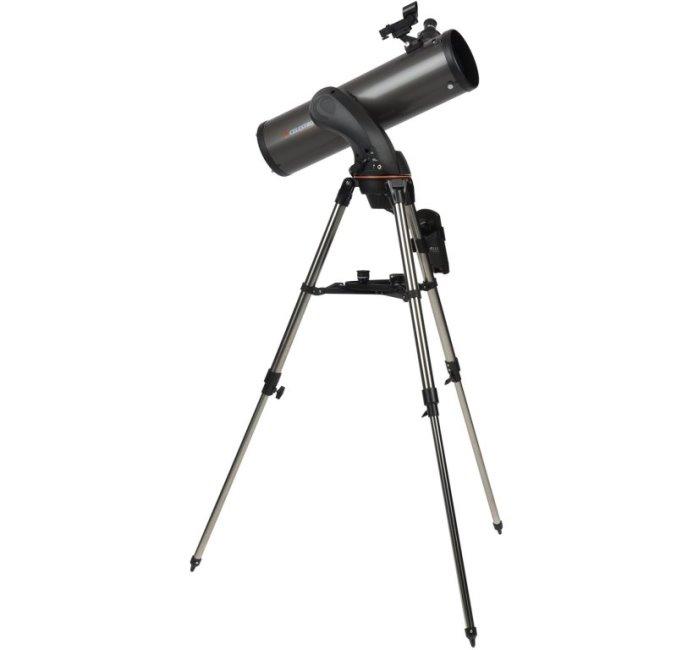
This telescope belongs to the latest series of devices equipped with computer control. This design is designed specifically for people who have just begun to comprehend the basics of observing celestial bodies. In the manufacture of the telescope, the latest technology of automatic targeting was used, the control system here is intuitive. The kit comes with a number of additional components that make the telescope fully ready for use. The tuning process is carried out through a special computer application, and there is no need to know the names of stars. The telescope itself will point its lens at the object selected in the existing database.
This can significantly save time on reconciliation with the cards of the starry him. Such a telescope is equipped with the most modern software; if necessary, it can be updated via the Internet. The connection unit of the telescope and mount has been modernized, so if necessary, you can quickly change the optical tube. To make the construction as stable as possible, instead of aluminum tripods, steel tubular tripods are used, which, if necessary, easily absorb even serious vibrations.
Benefits:
- Computerized telescope;
- Included is a remote control;
- Fairly high aperture;
- It is controlled using a special computer application;
- The highest increase can reach 307 times.
Disadvantages:
- Expensive.
Best Hybrid Telescopes
3. Levenhuk Skyline PRO 80 MAK
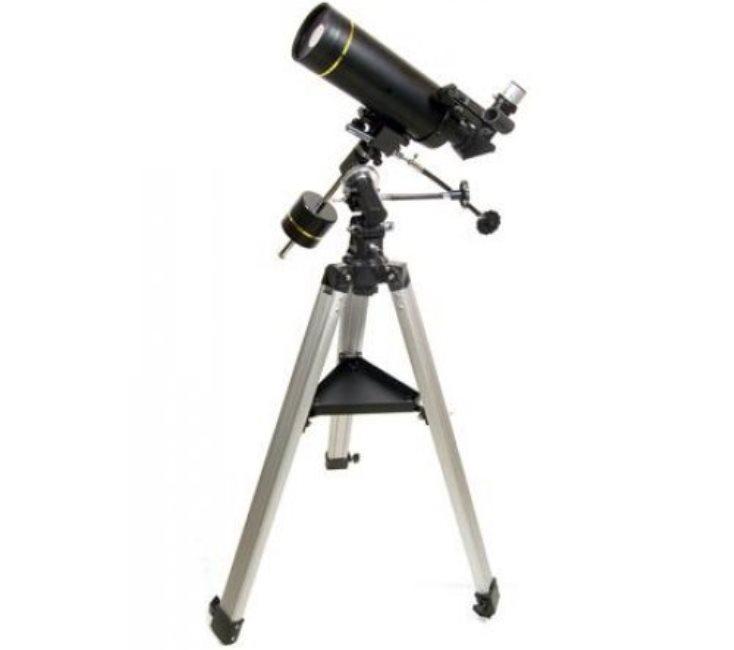
This model is considered by many astronomers to be professional, it is based on the Maksutov-Cassegrain system of lenses and mirrors. The telescope has a fairly compact size, the picture is very high quality. First of all, such a telescope is designed to observe distant cosmic objects - binary stars, clusters, nebulae and galaxies. The diameter of the lens is 80 mm. The telescope is mounted on a reliable equatorial mount of German production. The tool is well suited for field trips, especially since it does not weigh too much. The lenses are coated with antireflection compounds, so that maximum light passes through them. Mirror surfaces also have a special protective layer, which significantly increases their life.
The equatorial mount is equipped with handles of thin movements, a connector for installing an electric motor is provided. The mount has special circles of coordinates, due to which you can quickly find the desired object in celestial coordinates. The tripod is adjustable in height, there is a shelf.Using such a telescope, you can get the highest return, which will be very useful for both observing and for taking photographs of various space objects.
Benefits:
- Good aperture;
- Small size and weight;
- If necessary, you can connect all kinds of accessories.
Disadvantages:
- Costly construction.
2. CELESTRON NEXSTAR 4 SE

In second place in this section of the ranking of the best telescopes is a universal device with an attractive optical design. It is easy to install and has a compact size, and the cost is quite reasonable. The diameter of the main mirror is 102 mm. With such dimensions, it will be possible to discern relatively close objects located mainly within the solar system. The optics are treated with antireflection compounds, it is manufactured using Star Bright XLT technology, which minimizes possible light loss. Included with the telescope is a base that includes over 4,000 cataloged objects. If necessary, it can be updated via the Internet.
The telescope is fully computerized, a motorized fork mount is provided - this allows you to find and monitor space objects in automatic mode. SkyAlign guidance system - it is enough to point it at three stars, after which it will align the device. This feature is very convenient for beginners. The telescope operates on the basis of the Maksutov-Kassergren optical scheme; it will not need additional color calibration. The dimensions of the optical tube are insignificant, it is also characterized by low weight. It is very simple to put up a tripod.
Benefits:
- It is brought into working position in just a few minutes;
- Portable overall dimensions;
- Light weight;
- No calibration required.
Disadvantages:
- Due to the diameter of the main mirror, it is not always possible to consider objects located in deep space.
1. Levenhuk SkyMatic 105 GT MAK

The undisputed leader in its segment of the best telescopes is this design, which has a guidance function. Another important advantage in terms of equipment operation is a relatively small weight and compact overall dimensions. This was achieved largely due to the use of the Maksutov-Cassegrain optical scheme. The diameter of the main mirror is 102 mm, the focal length is significant - this allows you to consider both quite distant objects such as nebulae or star clusters, and close ones - planets, comets, asteroids, satellites and so on. The mount is equipped with drives for each axis, due to which it is possible to take photos with short shutter speeds. Using a standard SLR camera or even a webcam, you can get excellent broadcast from the lunar surface. The telescope finds all the required objects on its own.
The azimuth mount with the automatic guidance function is very simple to control - even a child can figure it out. The guidance is carried out using a special remote control having the SynScan AZ system. The database contains over 40,000 space objects. If necessary, the telescope is connected to a laptop or personal computer - for this there is a special cable, control is carried out using a number of programs. Together with the telescope are two eyepieces with focal lengths of 10 and 25 mm.
Benefits:
- Can be controlled by computer;
- There is a function of automatic guidance on objects;
- If necessary, you can connect all kinds of accessories;
- The tripod is very comfortable and weighs a bit.
Disadvantages:
- It costs expensive.
In conclusion, we offer a thematic video
Our review of the best telescopes of 2019 has come to its logical conclusion. We hope that from the considered tools for you the most suitable was found.If you have any questions about this or that product, you can ask us in the comments to this article.

